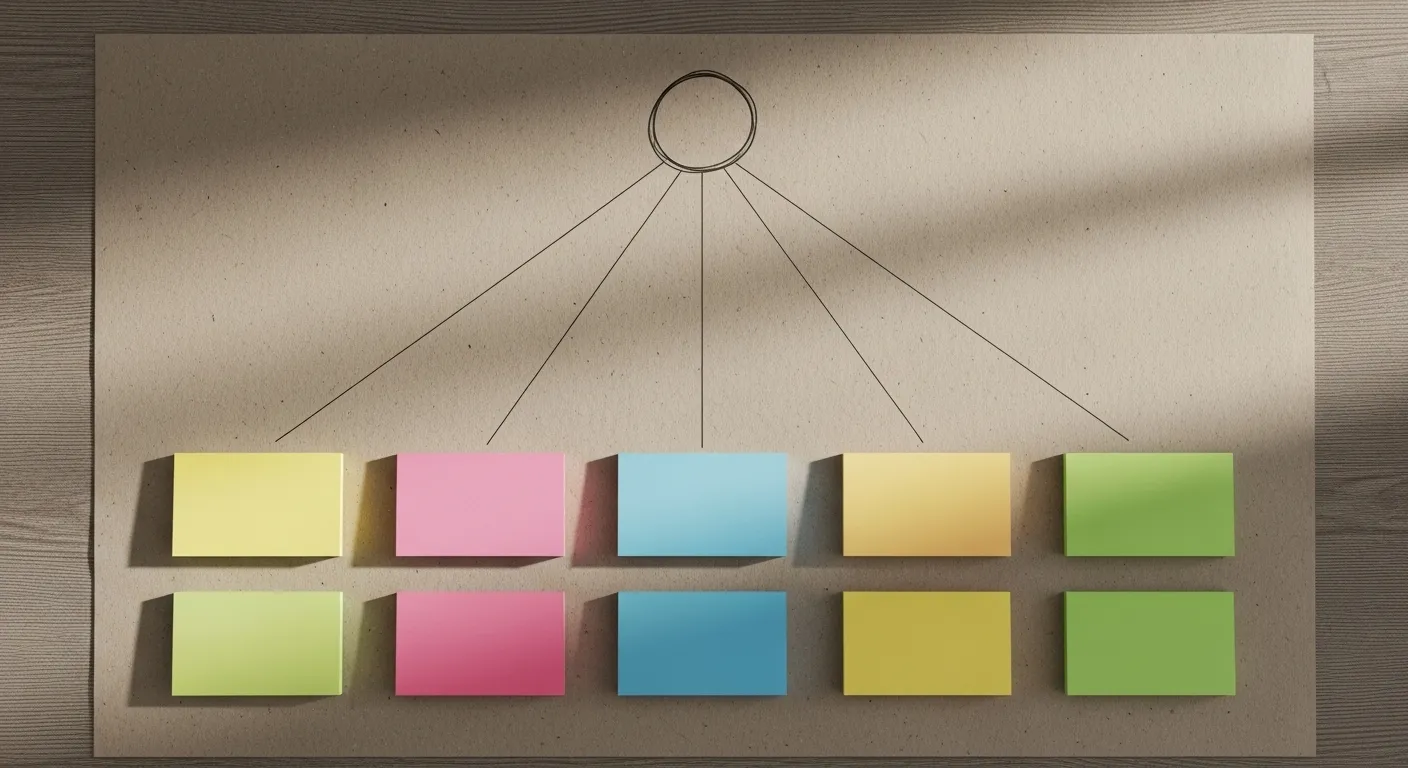
📚 Table of Contents
- Why Grand Plans Fail and Simple Systems Win
- Breaking Down the “1-3-5” Rule: Your Daily Blueprint
- Setting the Stage: Micro-Habits That Make Planning Stick
- The One-Screen Phone: Your Digital Declutter
- The 10-Minute Desk Reset: A Physical Clean Slate
- The 15-Minute Weekly Review: Your Strategic Check-In
- The “Time Audit” Snippet: Discovering Where Your Time Really Goes
- Tooling for Simplicity: Calendars, Timers, and Shortcuts
- Your Calendar is Your Fortress
- Timers: The Unsung Heroes of Focus
- Shortcuts and Batching: Efficiency in Action
- The Compounding Effect: How Small Habits Create Big Momentum
- Putting It All Together: Two Sample Days
- Frequently Asked Questions About the 1-3-5 Rule
- What if my “big” task takes more than one day to complete?
- Is a specific app or tool required for this?
- What happens if I don’t finish everything on my list?
- How do I handle unexpected urgent tasks that pop up?
- What is “switching cost” and how does this rule help?
- When should I quit a productivity hack if it’s not working?
- Your First Step: How to Start Using the 1-3-5 Rule Today
- Disclaimer and Further Reading
Why Grand Plans Fail and Simple Systems Win
We’ve all been there. Sunday evening, filled with ambition. You map out the perfect week on a pristine spreadsheet. Every hour is accounted for, every goal is audacious. You plan to wake up at 5 AM, meditate, journal, hit the gym, and solve your company’s biggest problem before your first coffee. This is the week, you think, that everything changes.
By Tuesday morning, the spreadsheet is a monument to good intentions. A surprise meeting derailed your morning, a dozen urgent emails shattered your focus, and the heroic effort required to maintain the perfect schedule has left you feeling more exhausted than accomplished. The system collapsed under the first touch of reality.
This is the fundamental flaw of complex productivity systems. They demand perfection in an imperfect world. They rely on heroic, unsustainable bursts of willpower instead of building a foundation of reliable, low-friction habits. True productivity isn’t about having a perfect day; it’s about making consistent, meaningful progress even on the messy days.
That’s where simple frameworks come in. They aren’t about overhauling your entire life overnight. They are small, sturdy rudders that help you steer the ship, not complicated engines that are prone to breaking down. They work with your human nature, not against it. They acknowledge that you have limited energy, focus, and time.
Among the most effective of these simple frameworks is the 1-3-5 rule. It’s not a rigid, color-coded binder system. It’s a mental model, a simple daily planning rule that forces clarity and accepts the constraints of a real workday. It’s a productivity hack that provides structure without becoming a burden, helping you end the day with a feeling of accomplishment instead of a list of what you didn’t do.
This approach isn’t about doing more things; it’s about doing the right things. It’s a quiet rebellion against the cult of “busy” and a practical guide to being genuinely effective. Forget the heroic overhaul. Let’s build a simple, sustainable system that actually works.

Breaking Down the “1-3-5” Rule: Your Daily Blueprint
The beauty of the 1-3-5 rule is its elegant simplicity. It’s a structure you can memorize in ten seconds and implement on a sticky note, in a digital document, or just in your head. It’s designed to bring order to the natural chaos of a workday without adding complexity.
What is the 1-3-5 Rule?
The 1-3-5 rule is a straightforward method for daily planning that requires you to choose a manageable number of tasks to focus on each day. Instead of an endless, demoralizing to-do list, you commit to completing just nine tasks, broken down by their significance and effort.
Every day, your list will consist of:
One big task.
Three medium tasks.
Five small tasks.
That’s it. That’s the entire framework. Nine items. This structure immediately forces you to prioritize. You only have one slot for a major objective. You only have three for significant efforts. This built-in limitation prevents you from optimistically scheduling three major projects for a single day, a common recipe for failure and frustration.
The rule acknowledges a truth we often ignore: not all tasks are created equal. A real workday is a mix of deep, focused work, routine responsibilities, and minor administrative duties. The 1-3-5 method creates a balanced “portfolio” of tasks that reflects this reality, ensuring you make progress on major goals while still keeping the small-but-necessary wheels of your work turning.
How to Define Your “1,” “3,” and “5”
The effectiveness of this rule hinges on correctly categorizing your tasks. Getting this right is the key to a successful daily planning session. Here’s a practical guide to defining each category.
Your 1 Big Task is your non-negotiable priority for the day. This is the task that, if completed, would make you feel like you won the day, regardless of what else happened. It typically requires significant focus and a dedicated block of time, usually between two and four hours. This is not “answer emails.” This is “draft the complete Q4 marketing strategy” or “write the first 1,500 words of the project proposal.” It’s the task you are most likely to procrastinate on because of its size, but it delivers the most value.
Your 3 Medium Tasks are important but less demanding. These are the workhorses of your day. They require a moderate amount of effort, often taking between 30 and 60 minutes to complete. Examples include preparing a presentation for tomorrow’s meeting, providing detailed feedback on a colleague’s work, outlining an article, or following up on a series of important sales leads. These tasks move projects forward but don’t require the same deep, uninterrupted concentration as your “1.”
Your 5 Small Tasks are the quick, low-effort items that can be handled in 15 minutes or less. These are the administrative and logistical duties that keep your work life organized. Think of things like scheduling a doctor’s appointment, responding to a specific non-urgent email, approving an expense report, or filing a document. These tasks are perfect for batching together or using to fill small, awkward gaps in your schedule, like the ten minutes before a meeting starts.
By sorting your potential to-dos into these three buckets, you’re not just making a list; you’re creating a realistic and strategic plan of action for your day.

Setting the Stage: Micro-Habits That Make Planning Stick
The 1-3-5 rule provides a brilliant structure for your day, but a structure is only as strong as its foundation. To get the most out of this simple daily planning rule, you need to create an environment—both physical and digital—that supports focus and minimizes friction. This is where micro-habits come in. These are tiny, almost effortless routines that, when practiced consistently, build a powerful platform for productivity.
These aren’t massive life changes. They are small adjustments that make it easier to follow your plan and harder to get derailed by distraction. Think of them as the support crew for your 1-3-5 list.
The One-Screen Phone: Your Digital Declutter
Our smartphones are an incredible source of distraction. The mere sight of a social media or news app icon can trigger a subconscious urge to open it, pulling you away from your intended task. The “one-screen phone” is a simple but profound productivity hack to counteract this.
Here’s how you do it: Take every single app on your phone’s home screen—except for the absolute essentials like Phone, Messages, and maybe your Calendar—and drag them into a single folder. Now, move that folder to the second page of your phone. Your home screen should be nearly blank. The goal is to break the mindless muscle memory of tapping on an app just because it’s there. To get to your distracting apps, you now have to consciously swipe to the next screen, open the folder, and find the app. This tiny bit of friction is often enough to make you pause and ask, “Do I really need to open this right now?” It transforms your phone from a temptation machine back into a tool.
The 10-Minute Desk Reset: A Physical Clean Slate
A cluttered desk can lead to a cluttered mind. The visual noise of stacked papers, empty coffee mugs, and tangled wires creates a low-grade level of stress and makes it harder to focus on the task at hand. The 10-minute desk reset is your end-of-day ritual to combat this.
Before you shut down your computer for the day, set a timer for ten minutes. In that time, do a rapid tidy-up. Put away papers, throw out trash, wipe down the surface, and arrange your keyboard and mouse for the next morning. It’s a small investment of time that provides an outsized psychological return. When you arrive at your desk the next morning, you are greeted with a clean, orderly space. This sense of calm and control makes it infinitely easier to sit down and begin working on your “1” big task without feeling overwhelmed before you even start.
The 15-Minute Weekly Review: Your Strategic Check-In
Effective daily planning doesn’t happen in a vacuum. It’s informed by a larger strategy. The 15-minute weekly review is your command center for the week ahead. Block out a recurring 15-minute appointment with yourself every Friday afternoon or Sunday evening.
During this time, you’ll do three things. First, look back at the past week’s calendar and to-do lists to see what you accomplished and what got pushed aside. Second, look forward at the upcoming week’s appointments and deadlines. Third, based on this information, identify the major priorities for the coming week. This is where you’ll spot the likely candidates for your “1” big task for each day. This short, strategic check-in ensures that your daily 1-3-5 lists are aligned with your larger goals, preventing you from being busy but not productive.
The “Time Audit” Snippet: Discovering Where Your Time Really Goes
Many of us have a vague idea of how we spend our time, but we are often wrong. A time audit is the practice of systematically tracking your activities to get an accurate picture of your day. A full-blown audit can feel intimidating, so start with a simple “snippet.”
For just two days this week, grab a notebook or open a simple text file. Every 30 or 60 minutes, write down what you just did. Be honest and non-judgmental. If you spent 30 minutes scrolling social media, write it down. The goal isn’t to shame yourself; it’s to gather data. You might discover that “quick checks” of your email are actually taking up 90 minutes of your day, or that you’re most focused between 10 AM and noon. This awareness is gold. It helps you make more realistic 1-3-5 plans and identify time-wasting habits that are sabotaging your best intentions.

Tooling for Simplicity: Calendars, Timers, and Shortcuts
While the 1-3-5 rule is fundamentally a habit, the right tools can act as powerful accelerators, making the system easier to implement and stick with. The key is to choose tools that serve the principle of simplicity. You don’t need a complex project management suite with a steep learning curve. You need simple, reliable tools that reduce friction, not add to it. Your calendar, a timer, and a few basic techniques are all you need.
Your Calendar is Your Fortress
Your calendar should be more than just a list of meetings. It should be a visual representation of your commitments, including your commitments to yourself and your most important work. This is where the technique of timeboxing comes into play.
Timeboxing, also known as time blocking, is the practice of scheduling a specific block of time on your calendar to work on a particular task. Instead of just having a to-do list, you are assigning your tasks a time and a place to live. This is especially critical for your “1” big task.
Here’s the exact process: Once you’ve identified your “1” for the day—let’s say it’s “Finalize Q3 Budget Proposal”—open your digital calendar. Find a two-hour block of uninterrupted time, ideally during your most energetic part of the day. Create a new event. Title it “DEEP WORK: Finalize Q3 Budget Proposal.” Color-code it if you like. Most importantly, treat this block with the same respect you would a meeting with your CEO. Decline other invitations that conflict with it. Silence your notifications during this time. You are building a fortress around your focus, and your calendar is the blueprint.
Timers: The Unsung Heroes of Focus
A simple timer is one of the most underrated productivity hacks available. It introduces a sense of gentle urgency and helps combat Parkinson’s Law, the idea that work expands to fill the time allotted for its completion. When you know you only have 45 minutes for a medium task, you’re less likely to get lost in perfectionism or distracted by tangents.
You can use the timer on your phone, a physical kitchen timer, or a web-based timer. For your “3” medium tasks, set a timer for 30, 45, or 60 minutes. For your “5” small tasks, a 10 or 15-minute timer can keep you moving at a brisk pace. This practice isn’t about creating a stressful race against the clock. It’s about defining a clear container for your effort, which helps you stay on track and provides a clear “finish line” for each task, delivering a satisfying sense of completion.
Shortcuts and Batching: Efficiency in Action
Your “5” small tasks can feel like a nuisance, death by a thousand paper cuts. They are necessary but can fragment your attention if handled sporadically throughout the day. The solution is batching.
Batching is the simple technique of grouping similar tasks together and executing them in a single, dedicated session. Instead of answering each email as it arrives, you can create a 30-minute time block on your calendar called “Process Email” and handle your five email-related small tasks all at once. Instead of making three separate phone calls at different times, batch them into one 15-minute block.
This method is powerful because it minimizes the mental cost of task switching. Your brain doesn’t have to constantly re-orient itself from writing a report, to scheduling a meeting, to approving an expense. By staying in “email mode” or “phone call mode,” you operate far more efficiently. Look at your list of five small tasks and see which ones can be grouped. Then, timebox a “batch session” on your calendar and use a timer to work through them quickly and effectively.

The Compounding Effect: How Small Habits Create Big Momentum
The true power of the 1-3-5 rule and its supporting micro-habits doesn’t come from practicing them in isolation. It comes from the compounding effect they create when they are chained together. Each small, positive action makes the next one easier, building a powerful upward spiral of focus and accomplishment. A single good habit is a step; a system of interconnected habits creates momentum.
Imagine this scenario. On Sunday evening, you perform your 15-minute weekly review. You look at your upcoming week and identify that your highest priority for Monday is to finish a critical client presentation. That becomes your “1” big task. Before logging off, you do your 10-minute desk reset, leaving your workspace clean and inviting.
On Monday morning, you arrive at a clear desk, feeling calm instead of chaotic. You already know your priority. You open your calendar and use timeboxing to schedule a 90-minute block from 9:00 AM to 10:30 AM dedicated solely to that presentation. When 9:00 AM arrives, you silence your phone—which is easy, because your distracting apps are already hidden away thanks to your one-screen setup. You set a timer and dive into the work, fully focused.
After your deep work session, you take a short break. Then you look at your three medium tasks. One of them is to catch up on industry news. You timebox 30 minutes for that. You work on another, and then before lunch, you see a 20-minute gap in your schedule. Perfect. You use batching to knock out three of your five small tasks—all of which involve quick emails—in one focused burst.
Each habit seamlessly flows into the next. The weekly review provides the strategy. The desk reset prepares the environment. The 1-3-5 list provides the daily plan. Timeboxing protects your focus. The timer creates intensity. Batching handles the small stuff efficiently. This isn’t a series of disconnected productivity hacks; it’s an integrated system where each component reinforces the others.
The Danger of Over-Optimization
As you begin to feel the benefits of this system, it can be tempting to take it to the extreme. You might start trying to optimize every single minute, creating a schedule so rigid that it shatters at the first sign of an unexpected problem. This is a critical trap to avoid. The goal of the 1-3-5 rule is to bring clarity and intention to your day, not to turn you into a robot.
Remember that the 1-3-5 list is a guide, not a gospel. It is a tool to help you make better decisions, not a stick to beat yourself with. If an urgent, high-priority task lands on your desk and displaces your planned “1,” that’s okay. The framework helps you make that decision consciously. You can look at your list and ask, “Is this new task more important than my planned ‘1’?”
Some days you won’t finish all nine tasks. Life happens. A colleague needs help, a child gets sick, a project takes longer than expected. The goal is not perfection; it is consistency. Ending the day having completed your one big task and two of your medium tasks is a huge win. The system is there to serve you, not the other way around. Guard against the tendency to let the management of the system become more work than the work itself. Keep it simple, stay flexible, and focus on progress, not perfection.

Putting It All Together: Two Sample Days
Theory is useful, but seeing a system in action is where it truly clicks. Let’s walk through how two very different professionals might apply the 1-3-5 rule and its supporting techniques to structure their day. One is a manager whose schedule is often dictated by meetings, and the other is a solo creator with large blocks of self-directed time.
Scenario 1: The Busy Manager
Aisha is a marketing manager. Her calendar is a patchwork of team meetings, one-on-ones, and cross-departmental syncs. Her biggest challenge is carving out time for strategic work amidst the constant communication.
At the end of the previous day, Aisha takes ten minutes to draft her 1-3-5 list for today.
Her 1 Big Task: Finalize and submit the Q3 budget proposal. This requires two hours of focused spreadsheet analysis and writing, and the deadline is tomorrow.
Her 3 Medium Tasks:
1. Prepare the agenda and slides for her weekly team meeting.
2. Review a junior team member’s campaign brief and provide constructive feedback.
3. Review the project management dashboard and send a brief status update email to stakeholders.
Her 5 Small Tasks:
1. Approve two expense reports in the HR system.
2. Schedule a 30-minute 1:1 with a new hire for next week.
3. Respond to an urgent IT ticket about software access.
4. Book a conference room for the end-of-quarter review.
5. Send a quick follow-up email to a vendor from yesterday’s call.
How she executes it: Aisha knows her most productive time is early morning. She has a meeting at 11 AM. She immediately timeboxes 8:30 AM to 10:30 AM on her calendar as “DO NOT DISTURB – Budget Work.” She informs her team she will be offline during this time. After her deep work session, she uses the 30 minutes before her 11 AM meeting to complete her second medium task: reviewing the campaign brief. After a block of afternoon meetings, she timeboxes another 45 minutes to prepare for her team meeting. She then notices a 20-minute gap later in the day and creates a calendar event called “Admin Batch.” During that time, she knocks out all five of her small tasks in one go. Even with a packed meeting schedule, the 1-3-5 list ensures she makes progress on her most critical deliverable and stays on top of her other responsibilities.
Scenario 2: The Solo Creator
Ben is a freelance writer and content creator. His days are largely unstructured, which can be both a blessing and a curse. His challenge is maintaining focus and momentum without external deadlines or a boss looking over his shoulder.
Ben plans his day every morning with a cup of coffee.
His 1 Big Task: Write 1,500 words of a new long-form blog article. This is his core value-producing activity and requires deep creative focus.
His 3 Medium Tasks:
1. Research keywords and competitors for his next article topic.
2. Create a set of three social media graphics to promote his most recently published post.
3. Outline the script for an upcoming YouTube video.
His 5 Small Tasks:
1. Reply to five comments on his blog.
2. Update a plugin on his website.
3. Draft and schedule his weekly email newsletter.
4. Send an invoice to a client for a completed project.
5. Check his affiliate sales dashboard and record the numbers.
How he executes it: Ben knows his creative energy is highest before noon. He timeboxes a three-hour block from 9 AM to 12 PM for his “1” big task of writing. He uses a timer, working in 50-minute sprints with 10-minute breaks. After lunch, when his energy for deep work is lower, he shifts to his medium tasks. He spends an hour on keyword research, then 45 minutes on the social media graphics. He saves the video script outline for late afternoon. He batches all five of his small, administrative tasks into a single 30-minute block at the end of his day, which he calls his “business shutdown” routine. The 1-3-5 framework gives his flexible schedule the structure it needs, ensuring he balances high-value creative work with the necessary tasks of running his business.

Frequently Asked Questions About the 1-3-5 Rule
As you start to implement any new productivity system, questions will inevitably arise. Here are answers to some of the most common queries about the 1-3-5 rule to help you navigate the initial learning curve and adapt it to your specific needs.
What if my “big” task takes more than one day to complete?
This is a very common and excellent question. Very few significant projects can be completed in a single two-to-four-hour block. The key is to break the project down into smaller, concrete chunks. Your “1” big task for the day shouldn’t be “Write a book.” It should be “Outline Chapter 3” or “Write 2,000 words of the first draft.” For a large project like “Develop a new software feature,” your daily “1” might be “Code the user authentication module” one day and “Write the API documentation” the next. The 1-3-5 rule works best when the tasks are specific actions you can realistically complete within the day.
Is a specific app or tool required for this?
Absolutely not. This is one of the greatest strengths of the 1-3-5 rule. You can implement it with any tool you already use, or with no digital tool at all. A sticky note on your monitor, a page in a paper journal, or a simple text file on your computer are all perfectly sufficient. The power of this productivity hack is in the mental habit of prioritization, not in a fancy piece of software. The best tool is the one you will use consistently, so choose whatever has the least amount of friction for you.
What happens if I don’t finish everything on my list?
It’s important to view your 1-3-5 list as a guide, not a contract. Life is unpredictable, and there will be days when you don’t complete all nine tasks. This is not a failure; it is simply data. When your day ends, take 60 seconds to review what’s left. Was the task more complex than you estimated? Did an unexpected emergency arise? If an unfinished task is still important, simply move it to your list for the next day. The goal is progress, not perfection. Consistently finishing your “1” and a few other items is a massive success.
How do I handle unexpected urgent tasks that pop up?
Unexpected tasks are a fact of life. When a new “urgent” request arrives, the 1-3-5 framework gives you a tool for making a conscious decision. Before you drop everything, compare the new task to your existing list. Ask yourself: “Is this new item more important than my planned ‘1’ big task? Is it more important than one of my ‘3’ medium tasks?” Sometimes, the answer is yes. In that case, you can consciously swap it in. Other times, you’ll realize the “urgent” task can actually wait or can be delegated. The rule prevents you from reacting mindlessly and helps you protect your planned priorities.
What is “switching cost” and how does this rule help?
Switching cost, also called context switching, is the mental energy and time you lose when you shift your attention from one task to another. Every time you stop writing a report to answer a quick email and then try to go back to the report, your brain has to expend effort to reload the context of the original task. The 1-3-5 rule helps minimize this cost in two ways. First, by encouraging you to dedicate a large, protected block of time to your “1” big task, it promotes deep, uninterrupted focus. Second, by encouraging the batching of your “5” small tasks, it reduces the number of times you switch between different types of low-level work.
When should I quit a productivity hack if it’s not working?
Give any new system a fair trial, which is typically one to two weeks of consistent effort. This gives you time to get past the initial awkwardness. After that period, evaluate it honestly. Is the system adding more stress and overhead than it’s relieving? Does it genuinely feel incompatible with the nature of your work? If so, it might not be the right fit for you. The ultimate goal of any productivity hack is to reduce friction and increase your effectiveness and well-being. If a system consistently fails to do that, it’s okay to abandon it and try something else.

Your First Step: How to Start Using the 1-3-5 Rule Today
The journey from feeling overwhelmed and reactive to feeling focused and in control doesn’t require a giant leap. It begins with a single, simple step. The 1-3-5 rule is designed for action, not just theory. Its value is unlocked the moment you put it into practice. You don’t need to wait for a new week, a new month, or a new job to begin. You can start right now.
The core benefit you are working toward is clarity. It’s the feeling of knowing exactly what you need to do and having a realistic plan to do it. It’s the quiet confidence that comes from replacing a chaotic, endless to-do list with a short, prioritized, and achievable set of goals. This system helps you win the day, and winning the day, consistently, is how you build a successful and satisfying career and life.
Don’t let the simplicity of the rule fool you. It is a powerful engine for focus. By deliberately choosing what matters most, you are also choosing what to ignore, which is an equally important skill in our age of infinite distraction. It’s time to trade the stress of “busy” for the satisfaction of “done.”
Here are three simple actions you can take today to begin implementing the 1-3-5 rule:
1. Plan Tomorrow, Tonight. Before you finish your work for the day, take just ten minutes. Grab a piece of paper or open a notes app. Look at your calendar and your project list, and create your first 1-3-5 list for tomorrow. Identify that one crucial task, those three important items, and those five small things. The simple act of writing it down will create powerful intention.
2. Try One Micro-Habit. You don’t need to adopt every supporting habit at once. Pick just one to experiment with this week. Maybe it’s the 10-minute desk reset tonight. Or perhaps you’ll try the one-screen phone setup right now. Choose the one that seems easiest or most appealing and commit to trying it for three days.
3. Timebox Your “1” Right Now. Open your calendar for tomorrow. Find the best possible time block for your most important task and schedule it. Title it “FOCUS WORK” or “DEEP WORK” and treat it as an unbreakable appointment. This single action can dramatically increase the odds that you will actually do it.
Remember, the goal is not perfection. Your first list might be flawed. You might get interrupted. That is part of the process. The aim is to build a new habit, and the only way to do that is to start. Start small, start today, and give yourself the gift of a more focused and intentional tomorrow.

Disclaimer and Further Reading
The information provided in this article is for educational and informational purposes only and is not intended as a substitute for professional medical, psychological, or legal advice. The Focused Method is not a licensed medical or legal provider. You should always consult with a qualified professional for any health concerns or before making any decisions related to your health or legal standing.
Productivity and well-being are deeply connected to factors like mental health, sleep, and overall wellness. For authoritative information on these topics, we encourage you to visit the homepages of reputable organizations.
For information on psychology and mental health, you can visit the American Psychological Association at https://www.apa.org.
For general health and wellness research, a valuable resource is the National Institutes of Health at https://www.nih.gov.
For evidence-based information on the importance of sleep for cognitive function and productivity, visit the Sleep Foundation at https://www.sleepfoundation.org.






